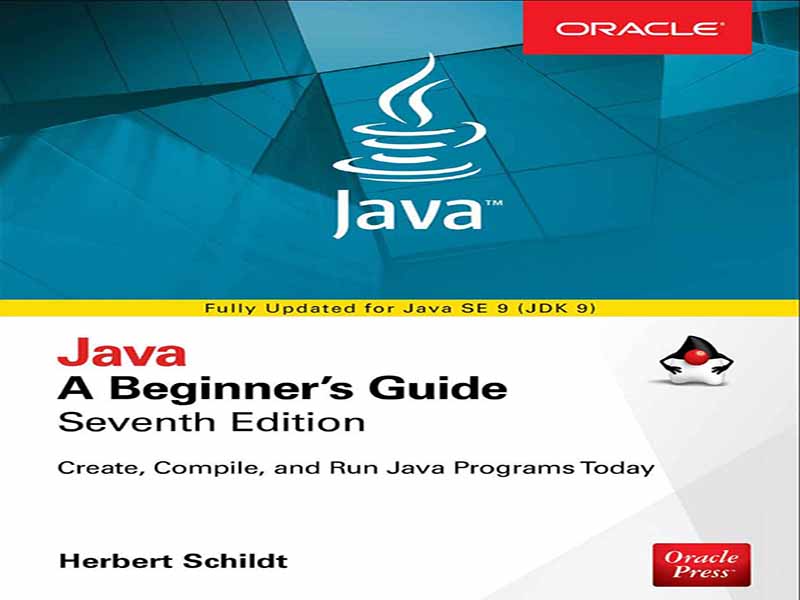- عنوان کتاب: Java A Beginners Guide, Seventh Edition
- نویسنده: Herbert Schildt
- حوزه: برنامه نویسی جاوا
- سال انتشار: 2018
- تعداد صفحه: 1010
- زبان اصلی: انگلیسی
- نوع فایل: pdf
- حجم فایل: 37.3 مگابایت
هدف این کتاب آموزش اصول برنامهنویسی جاوا به شماست. این کتاب از یک رویکرد گام به گام همراه با مثالهای متعدد، خودآزماییها و پروژهها استفاده میکند. فرض بر این است که هیچ تجربه برنامهنویسی قبلی ندارید. این کتاب با اصول اولیه، مانند نحوه کامپایل و اجرای یک برنامه جاوا شروع میشود. سپس کلمات کلیدی، ویژگیها و ساختارهایی را که هسته زبان جاوا را تشکیل میدهند، مورد بحث قرار میدهد. همچنین پوششی از برخی از پیشرفتهترین ویژگیهای جاوا، از جمله برنامهنویسی چند رشتهای، ژنریکها، عبارات لامبدا و ماژولها را خواهید یافت. مقدمهای بر اصول Swing و JavaFX کتاب را به پایان میرساند. در پایان، درک کاملی از اصول برنامهنویسی جاوا خواهید داشت. ذکر این نکته در ابتدا مهم است که این کتاب فقط یک نقطه شروع است. جاوا چیزی بیش از عناصری است که زبان را تعریف میکنند. جاوا همچنین شامل کتابخانهها و ابزارهای گستردهای است که به توسعه برنامهها کمک میکنند. یک برنامهنویس درجه یک جاوا بودن، تسلط بر این حوزهها را نیز ایجاب میکند. پس از اتمام این کتاب، دانش لازم برای دنبال کردن هر جنبه دیگری از جاوا را خواهید داشت. تکامل جاوا تنها چند زبان، ماهیت برنامهنویسی را اساساً تغییر دادهاند. در این گروه نخبه، یکی برجسته است زیرا تأثیر آن هم سریع و هم گسترده بود. این زبان، البته، جاوا است. اغراق نیست اگر بگوییم که انتشار اولیه جاوا ۱.۰ در سال ۱۹۹۵ توسط شرکت سان میکروسیستمز، انقلابی در برنامهنویسی ایجاد کرد. این انقلاب، وب را به طور اساسی به یک محیط بسیار تعاملی تبدیل کرد. در این فرآیند، جاوا استاندارد جدیدی را در طراحی زبان کامپیوتر تعیین کرد. در طول سالها، جاوا به رشد، تکامل و تعریف مجدد خود ادامه داده است. برخلاف بسیاری از زبانهای دیگر که در گنجاندن ویژگیهای جدید کند هستند، جاوا اغلب در خط مقدم توسعه زبان کامپیوتر بوده است. یکی از دلایل این امر، فرهنگ نوآوری و تغییری است که جاوا را احاطه کرده است. در نتیجه، جاوا چندین ارتقاء را پشت سر گذاشته است – برخی نسبتاً کوچک و برخی دیگر قابل توجهتر. اولین بهروزرسانی بزرگ جاوا نسخه ۱.۱ بود. ویژگیهای اضافه شده توسط جاوا ۱.۱ بسیار قابل توجهتر از افزایش تعداد نسخههای جزئی بود که شما فکر میکنید. برای مثال، جاوا ۱.۱ عناصر کتابخانهای جدید زیادی اضافه کرد، نحوه مدیریت رویدادها را دوباره تعریف کرد و بسیاری از ویژگیهای کتابخانه اصلی ۱.۰ را دوباره پیکربندی کرد. نسخه اصلی بعدی جاوا، جاوا ۲ بود که در آن عدد ۲ نشان دهنده «نسل دوم» است. ایجاد جاوا ۲ یک رویداد مهم بود و آغاز «عصر مدرن» جاوا را رقم زد. اولین نسخه جاوا ۲ دارای شماره نسخه ۱.۲ بود. ممکن است عجیب به نظر برسد که اولین نسخه جاوا ۲ از شماره نسخه ۱.۲ استفاده کرده است. دلیل آن این است که در ابتدا به شماره نسخه داخلی کتابخانههای جاوا اشاره داشت، اما سپس به کل نسخه تعمیم داده شد. با جاوا ۲، شرکت سان محصول جاوا را به عنوان J2SE (نسخه استاندارد پلتفرم جاوا ۲) دوباره بستهبندی کرد و شماره نسخهها شروع به اعمال شدن به آن محصول کردند.
The purpose of this book is to teach you the fundamentals of Java programming. It uses a step-by-step approach complete with numerous examples, self tests, and projects. It assumes no previous programming experience. The book starts with the basics, such as how to compile and run a Java program. It then discusses the keywords, features, and constructs that form the core of the Java language. You’ll also find coverage of some of Java’s most advanced features, including multithreaded programming, generics, lambda expressions, and modules. An introduction to the fundamentals of Swing and JavaFX concludes the book. By the time you finish, you will have a firm grasp of the essentials of Java programming. It is important to state at the outset that this book is just a starting point. Java is more than just the elements that define the language. Java also includes extensive libraries and tools that aid in the development of programs. To be a top-notch Java programmer implies mastery of these areas, too. After completing this book, you will have the knowledge to pursue any and all other aspects of Java. The Evolution of Java Only a few languages have fundamentally reshaped the very essence of programming. In this elite group, one stands out because its impact was both rapid and widespread. This language is, of course, Java. It is not an overstatement to say that the original release of Java 1.0 in 1995 by Sun Microsystems, Inc., caused a revolution in programming. This revolution radically transformed the Web into a highly interactive environment. In the process, Java set a new standard in computer language design. Over the years, Java has continued to grow, evolve, and otherwise redefine itself. Unlike many other languages, which are slow to incorporate new features, Java has often been at the forefront of computer language development. One reason for this is the culture of innovation and change that came to surround Java. As a result, Java has gone through several upgrades—some relatively small, others more significant. The first major update to Java was version 1.1. The features added by Java 1.1 were more substantial than the increase in the minor revision number would have you think. For example, Java 1.1 added many new library elements, redefined the way events are handled, and reconfigured many features of the original 1.0 library. The next major release of Java was Java 2, where the 2 indicates “second generation.” The creation of Java 2 was a watershed event, marking the beginning of Java’s “modern age.” The first release of Java 2 carried the version number 1.2. It may seem odd that the first release of Java 2 used the 1.2 version number. The reason is that it originally referred to the internal version number of the Java libraries but then was generalized to refer to the entire release itself. With Java 2, Sun repackaged the Java product as J2SE (Java 2 Platform Standard Edition), and the version numbers began to be applied to that product.
این کتاب را میتوانید از لینک زیر بصورت رایگان دانلود کنید:
Download: Java A Beginners Guide, Seventh Edition




































نظرات کاربران